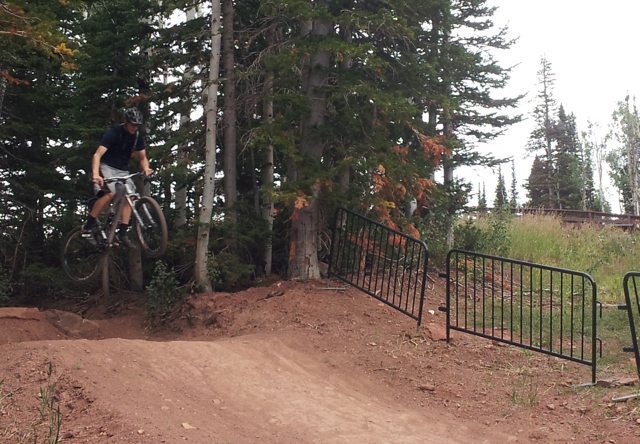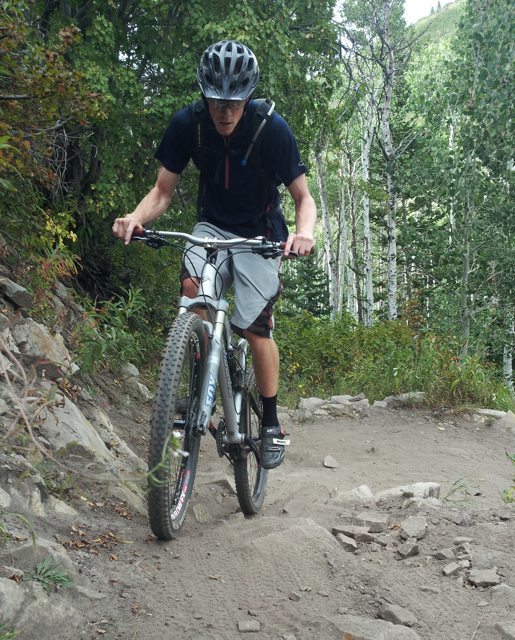Background
Before going further, I should provide a little background on how I like to ride, how I like my bike to ride, where I like to ride, etc.
I like challenges, so I enjoy technical trails that require bike-handling skills. (And yes, those are hard to find in the Salt Lake area.) For some reason I also like to hurt; I love to pedal my bike uphill in order to get a rewarding descent. I rarely shuttle or ride lifts. Lastly, I enjoy playing on my bike, bounding off everything in sight, and carving turns.
Really, I just love to ride bikes, whether doing wheelies down the street, riding buff singletrack, bike park, pump track, or Moab. I really don’t care.

When it comes to bikes, I (like everyone else) dream of something that feels efficient on the up, and is stable, plush, and playful for the down. Before my BLT2, I rode an ‘06 Rocky Mountain Slayer—definitely not the best climber, but the rear suspension provided incredible traction on technical climbs, and the faster I rode the bike downhill, the better it felt. Overall, that bike was amazing, especially for its time.
I moved on to higher-tech suspension when I bought the BLT2, perhaps a little more “trail” than “enduro” by today’s standards. (Not that I can clearly define either of those terms, but what kind of mountain bike article would this be without them?)
After a couple of seasons on the BLT2, I’d experienced broken pivots, a dented front triangle from a rock off the front tire, and far too many hair-raising moments to call myself anywhere close to satisfied with the bike.
Coming from the Slayer, the BLT2 climbed like a banshee (especially when rolling a pair of Enves!), but it didn’t inspire confidence when I was going fast downhill or negotiating technical descents. The square edge performance wasn’t very good.
I got tired of its twitchiness at high speeds and endo-iness on technical steeps, so with the new front triangle, I threw on a FSA Orbit Option to slacken the HT a degree. Unfortunately, the Orbit also switched to a 0-stack internal cup, so, coming from a Chris King external cup, the difference wasn’t satisfying and to this day it remains pretty close to 67° with the 160mm Fox 36 fork.
Quite honestly, before cramming 27.5” wheels on the bike, I was desperately trying to sell the BLT2.
Changes in Ride Quality
As I mentioned in the introduction, I felt a noticeable difference in ride quality when I put on the 27.5” wheels. Since I don’t race and haven’t timed a ride in years, feel is the only thing I have to offer for this article—sorry, no numerical data at this point.
The sensations felt while riding, however, are what make biking fun, so feel is the most important aspect for me. Of course, we all perceive differently, so take the following for what it’s worth.
While the Enve AM wheelset made me feel like a juiced-up pro cyclist when I mashed down on the pedals, the effect on nearly every other aspect of the ride turned out to be negligible compared to the Bontrager Rhythm Elites I’d ridden previously.

Jumping up to the 27.5″, I immediately noticed a number of positive attributes:
1) Visually, I could tell I was a touch higher. At the same time, my center of mass felt subtly lower in relation to the mass of the bike. In biking lingo, I believe this sensation is described as feeling “in” the bike as opposed to “on” the bike.
2) While rolling on level ground, the bike maintained constant speed with less effort. Pointed downhill, it seemed to pick up speed with less effort compared to any 26” wheel/tire combo I’ve ridden.
(And take note: when I compared the wheel/tire weights, the Flow EX/Toro actually weighed a few grams less (<100) than the Bontrager/2.5 DHF 3C EXO 26” setup.)
To expand on this, the 27.5 set-up “rolled” better than any setup I’ve used with 26” wheels. This includes a number of 26” wheelsets wrapped with DHF, Ignitor, BBG, Slant 6, SB8, Nevegal, Captain Control, Nokian NBT, Highrollers, Mountain King, and old Mybro tires.
I’m not talking about acceleration or how easy the wheels felt to pedal, (as in a low rolling resistance type of tire, which the Toro isn’t anyway. It’s that they felt like the tires had weight behind them (inertia), like it feels when you jump on a 29er.
This really didn’t come as a surprise.
3) Square edge hits became smoother and transmited less energy into the suspension and away from the direction of travel. The difference was subtle, but a noticeable improvement nonetheless. Does the BLT2 still eat up too much travel and become overwhelmed with fast or repeated square edge hits? Yes, but the 27.5s masked some of these issues.
4) Traction was greatly improved, not only during acceleration and deceleration, but also while cornering when I am steering or leaning the bike aggressively.
This is saying something considering I was coming off one of arguably the best traction tires on the market, the DHF 3C. Unfortunately, they don’t make a 27.5 DHF yet and I don’t have a 26” Toro to make a direct comparison. [Note: The DHF is now available in a 27.5! I have a set and will be putting them head-to-head against the 26ers as soon as possible.]
But keep in mind, the 26″ Toro has been available for a long time, and isn’t one of the tires on many people’s short list. Another point to keep in mind is the fact that the BB is 1.3 cm higher rolling with the 27.5s, which typically doesn’t translate to improved cornering ability.
5) The bike felt more stable in general. Obviously, the BLT2 doesn’t suddenly feel like a DH sled, but with the increased inertia, the difference is noticeable. Though the ~67° HT angle and wheelbase stayed constant, I’m more confident riding at speed and through steep, rocky technical sections.
The added bonus? The bike is more stable while still feeling equally capable on slow hairpin switchbacks as it did with the 26” setup.
6) The bike felt as flickable as ever for “normal” riding maneuvers—tossing the bike into corners, popping every roll and bump in sight, etc.

Drawbacks
I also noticed a few characteristics I would consider a decrease in performance:
- Most notably, accelerating the bike up steep climbs took more effort and could be felt on each pedal stroke.
- The bike wasn’t as easy to manipulate on bigger jumps (when I threw a little whip or table) compared to when I was rolling the 26ers.
- The tire definitely rubs on impacts that use the bike’s full travel. The only effect on ride is the “brrrp” noise. The effect on my frame is a small smear of rubber on the seat tube.
Bottom Line
So what does this translate to? For me, going 650b has transformed the BLT2, which I had been less than impressed with. I feel more stable at speed, I can push corners harder, and square edge bumps are much less of an annoyance and a momentum killer. I do still wish the bike had a steeper seat tube. So the wheels aren’t magical, but in my opinion, they improve many important ride qualities.
I’ve spent three months rolling 27.5” wheels, and I can without a doubt say that if I were to purchase a new 5-6” travel bike today, it would be a 27.5er. For the type of riding I do, it just feels better than a 26 or 29er, and that includes rolling my bike on a $2000+ carbon wheelset.
The good news here is that it seems that dropping $5,000-$6,000 on a new bike isn’t the only option consumers have to obtain a significantly different ride. In fact, these Stan’s Flow EX’s “only” run $595.00. Once you throw on a hundred or so dollars of rubber, you’re looking at ~$700.00 … if, if, if they fit.

So what 29ers have you written for comparison?
Comparable 29’er’s I have ridden are the Santa Cruz Tallboy and Giant Trance X 29er.
I’d recommend you try something with shorter stays, like a Honzo (HT) or the new Enduro for a FS.
Hey, thanks for the review of the Blur with 650b wheels! I bought my 2.2 with Stan’s Flow 650b wheelset and never looked back. I personally do not like the lower bb height of most bikes today, especially riding in the Northeast. I hate pedal strikes! I was thinking about buying a set of 26″ wheels just to try out on the Blur, but after reading your article, I may just save my money. Thanks, man!
Mr. K
“This is just simple physics—the larger wheel size has more rubber touching the ground[…]”
Simple physics says otherwise: P = F/A, completely independent of wheel radius.
You are absolutely correct. Sorry for my poor word choice! The contact patch does have a different shape, however, with the larger diameter tire being longer and skinnier. From my experience on 26, 27.5, and 29 inch wheels, this subtle difference does have a noticeable affect on traction.
I have a pair of 27.5 DHF’s now, and I’m super excited to try them head to head against the 26’s on this bike. I’ll be updating the article as soon as that process is complete.
Nice one. I’ve experienced the advantages of 650b myself, having picked up a SC BronsonC a little while ago. The advantage of the bigger wheel is most evident on off-camber roots, I’ve found.
Nice, honest, real-world write-up. And you’re right–the contact patch IS larger on the 27.5 (the formula above notwithstanding). I’m converting a Remedy 9.9 to 27.5 (with the same 36 TALAS up front), after falling in l ove with my KHS 650b…
Extraordinary claims demand extraordinary evidence. Where’s yours?
Nice! What would your bb height measure with the 27.5 wheels on the bike?